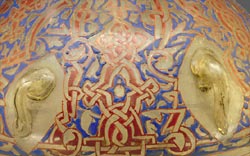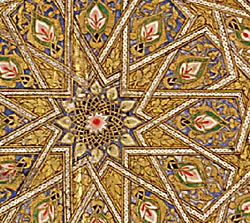
|
Contrary to the assumption that the Koran prohibits figurative representation, it only
warns against the creation and worship of idols to prevent idolatry. Fueled by more
orthodox interpretations of Islam, however, religious disapproval of figural representation
took hold shortly after the Prophet's death in 632. In general, Korans, religious
structures, and the furnishings for these spaces are devoid of figural imagery and
adorned primarily with abstract motifs and calligraphy. Figural representation, on the
other hand, is found on works of art created for use in a private, secular context. In part, the religious prohibitions encouraged the
development of a distinct abstract decorative language that became another principle
feature of the arts of the Islamic world.
This is the last page of Abstract Design
|


|